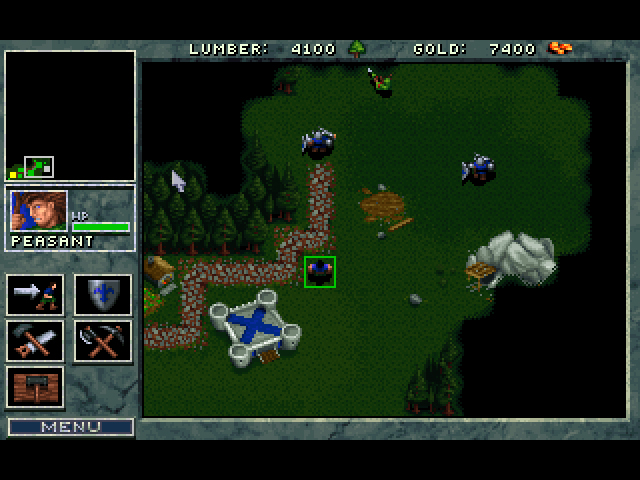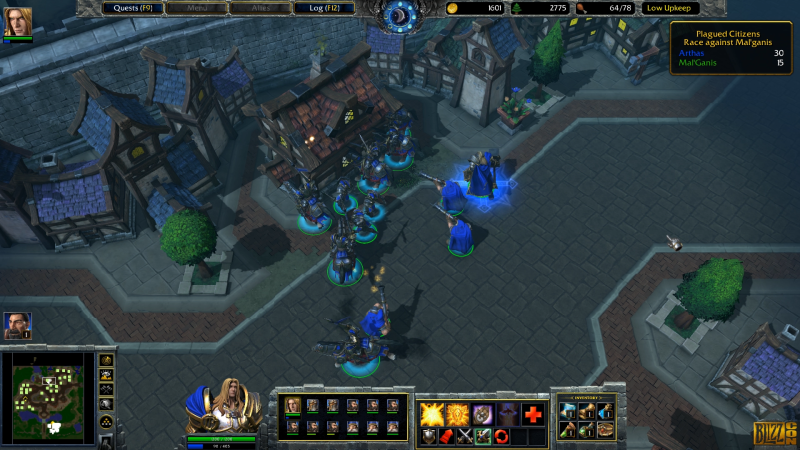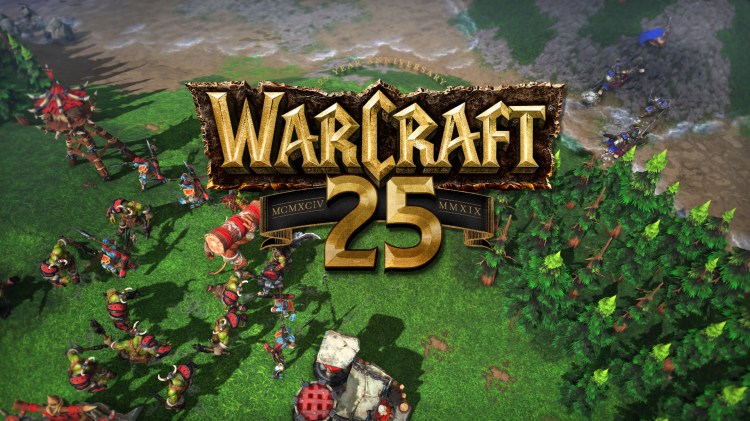This is a landmark year for Warcraft. World of Warcraft Classic will bring players back to the massively multiplayer online role-playing game’s earliest days when it launches on August 27. Warcraft III: Reforged is updating the popular real-time strategy games with new graphics. But the franchise is also celebrating a milestone birthday this year, as the original Warcraft: Orcs & Humans will celebrate its 25th anniversary this November.
Blizzard Entertainment launched Warcraft as a strategy series, but it has expanded into the world’s most popular online role-playing game with World of Warcraft and digital card game with Hearthstone. It’s also spawned novels and a Hollywood movie. The franchise has had a lot of growth in 25 years.
I chatted with two people familiar with Warcraft’s past and present during a special event last week that Blizzard hosted in Irvine, California. Samwise Didier has been creating art for the company since joining it all the way back in 1991 (back before it was even called Blizzard, instead known as Silicon & Synapse, Inc.). He is now a senior art director, having last worked on the crossover MOBA Heroes of the Storm. Kaeo Milker joined in 2001, first working on Warcraft III: Reign of Chaos. He went on to work on World of Warcraft and StarCraft II, and he is the production director for Heroes of the Storm.
I was able to talk with both men about Warcraft’s big anniversary.

Above: Samwise Didier and Kaeo Milker.
GamesBeat: With Warcraft turning 25 years old, what does the franchise mean to each of you?
Samwise Didier: To me it shows a quarter of a century of growth in my art style, and my company’s ability to make good games. We started out very small with [Warcraft:] Orcs and Humans, where it was basically just orcs and humans. The second game we started adding different races like dwarves and elves and goblins and dragons and trolls in there. Warcraft III evolved the art style even more into 3D, and introduced all sorts of tweaks and things, as well as some of our most well-known characters like Jaina, Thrall, Arthas, Illidan. And even then we evolved the art style even more for World of Warcraft and even Hearthstone, a totally different type of game.
To me it’s representative of an artistic sort of well that — almost anything we want to create artistically, we’re able to do it in the world of Warcraft. We want to have things travel into a different world and a different sort of outer space. It’s not your standard European medieval fantasy. We’ve been able to take fantasy and have Blizzard put its own stamp on it with things like night elves, with orcs that aren’t necessarily brutal and hostile, but noble, while still being primal, earthen warriors. It’s still something that I find creatively an inspiration, even 25 years later.
There’s not anything I’m bored with yet. Maybe in 25 more years, at 50, we’ll talk about it, and I’ll say, yeah, I’m starting to run out of ideas. And then I’ll put on my oxygen machine and we’ll come up with some new stuff.

Above: The original Warcraft.
Kaeo Milker: For me, I came in 10 years into the Warcraft journey. Warcraft III was the first game I worked on, Reign of Chaos. At that point we had this foundation that I think Warcraft III built upon, this revolutionary gameplay in terms of being hero-centric gameplay. That set the stage for World of Warcraft, giving us that first taste of persistence in characters that we’re leveling up and growing. There was that RPG element added to our RTS that paved the way for WoW.
Again, all the worlds and characters we introduced in that game — it laid the tracks to this world that we all got to explore together in WoW when it came out. Like Sam said, we didn’t stop there. Being able to delve deeper into that universe and pivot with Hearthstone, or bring it into Heroes of the Storm with the worlds and characters of Warcraft being reinterpreted in Heroes, it’s this place that we can continually go back to in different ways and have amazing experiences. We’re 25 years in, but it feels like we’re just getting started in a lot of ways. There’s so much left to explore.
Didier: As technology changes, too, we’re able to do more with the art. We’ve done it as an RTS, as an MMORPG, as a card game, as a movie. One of the great things about Warcraft, if you give me any type of game, we can make a great Warcraft game out of that. Like chess. Warcraft chess, we gotta do that. I’m sure it’s already out there.

Above: Warcraft II.
GamesBeat: Sam, is it true that you came up with the name Warcraft?
Didier: Yeah, it was my D&D character. Everyone’s familiar with the word witchcraft, people who are masters of spells and incantations. My guy was the opposite of that, the master of war. He had a weapon for every situation. Basically it was an excuse to have a character who had the spear, the sword, the axe, the mace, the crossbow, the shield, daggers all over the place. He was like the wizard of war. That’s where Warcraft came from.
GamesBeat: Warcraft III was an interesting turning point for the series. It went from some of the traditional fantasy and medieval stuff and added new concepts. How did such a big change occur?
Didier: It started in Warcraft II. The original Orcs and Humans had the knights, the crossbowmen, very traditional medieval sort of historical fantasy. There were still demons and water elementals, and on the orc side — I don’t remember if there were spear throwers or whatever, but the perfect example in Warcraft II — we don’t have to have it just be an orc throwing the spear. Let’s make him a troll. We don’t have to do a wolf rider if we don’t want to. We can make him an ogre. Same on the human side. Let’s do the elven rangers.

Above: Warcraft III: Reforged.
And then in Warcraft III, let’s do the dwarven riflemen. We started adding more and more as we created this. The characters and races became more and more their own. Nowadays you don’t think of our Warcraft elves as just the people with bows, like a traditional elf. They’re night elves. They can shapeshift. They can shadow meld. They worship the moon. They’re not the typical elf. Our dwarves are guys that run around with cannons and guns. They’re obviously dwarven blacksmiths, but they make these engineering marvels.
We really started building up our races from traditional fantasy, Dungeons & Dragons, Tolkien stuff, to make a Blizzard type of fantasy, a superheroes meeting fantasy sort of setting. It took a while. The first game is kind of boring, art-wise, in my opinion. Warcraft II really opened it up. Warcraft III built everything in this world and introduced high elves and tauren. Then World of Warcraft came out and took the world we created in Warcraft III and introduced it to the world. That was the main starting point for WoW being world-renowned — a world known by the world?
GamesBeat: Cinematics have always been important for Warcraft. Why have these movies been such a big part of the franchise?
Didier: I’d say that one of the reasons Warcraft has been around for 25 years — a lot of it is because Blizzard can make really good games. In all of the games, but specifically Warcraft, because people can really relate to fantasy. People have read the fairy tale books, or know what elves and dwarves are. But Warcraft had a very distinct art style. Lots of color, lots of bold shapes and silhouettes, and heroic characters. Take away the art — we’ve seen lots of games and movies that have great art, but you play it and you watch it and you think, that was not great. But Blizzard also has great games. You’re playing a great game. People are still playing multiplayer StarCraft games. They’re still playing World of Warcraft 15 years later, because the games are great. Now, we’re doing Reforged because the art is starting to get dated, but the gameplay is still great. Same with World of Warcraft. With Warcraft, we had great art, great gameplay.
You mentioned the cinematics. The cinematics were some of the first in the game industry, in my opinion, that felt like movies. We made them like they were movies. This is before we even had people from the movie industry working with us on these things. This was just a bunch of art guys getting together and wanting to make a Star Wars movie for our game. Then the soundtracks, we’ve always had soundtracks that felt like classical music compositions. So you have sound, gameplay, the art in the game, and the art in the movies all together. We were known for that. Every game had that.
And then one of the great things about Warcraft is it appealed to people who just liked single-player games. They just want to play the story and see the lore and hear how Arthas is a jerk and did bad things. And then you have the people who just play multiplayer, who just want to beat the hell out of their friends for years. I’m gonna play night elves and you’re gonna play orcs. It had a little bit of everything for everyone. Every little thing we did was done to make it the top of the industry.
Milker: What was interesting about the cinematics to me was that in the early days, the cinematics were the place where you went from these muddy little low-res pixel things to seeing them as your mind’s eye envisioned them. It connected the gameplay with the experience in a way that the gameplay itself couldn’t in those days. But as time goes on, the technology and art quality has gone up. The games now — when you’re playing a game like WoW or StarCraft II or Heroes, you’re getting to see really high fidelity stuff that looks great too. Then the cinematics become even more of this place to expand the story part of the game and take it to a whole other level. It’s been interesting to see that go from the only place to get that experience to augmenting that experience alongside the gameplay. But it’s been a long journey. Technology has certainly come a long way.
Didier: That was always one of the things I tried to avoid seeing. If I was working on the game, I had to be involved, but if I wasn’t working on the game, I wanted to not see any of the cinematics, because I wanted to see that magic, where we announced it at BlizzCon or wherever else. When we’re developing these games, we see how everything is made. We know all the difficult situations it takes to make these. But those cinematics are something where, myself, I can sit with the people at BlizzCon and we’re all seeing it for the first time and saying, my God, that’s what happens? This guy’s back? That guy’s dead? That was one of the things I always tried to save and enjoy as part of the Blizzard fandom.

